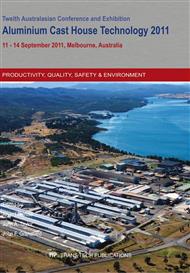p.196
p.208
p.217
p.227
p.235
p.247
p.256
p.264
p.276
The Effect of Calcium on the Rolling Behaviour and Hot Tensile Properties of AA5182
Abstract:
The impact of sodium on the edge cracking behaviour of high magnesium alloys such as 5182 has been the subject of many studies. Relatively less information is available on the role of calcium and much of this is contradictory, some authors reporting that relatively modest levels of Ca reduce hot ductility (and by inference promote edge cracking) whereas other reports recommend the intentional addition of calcium to these alloys in order to control oxidative casting defects such as vertical folds. This paper will describe and discuss a series of experiments in which AA5182 ingots containing sodium and calcium alone, and also in combination, were cast, hot-rolled and subsequently hot tensile tested. As expected, sodium alone led to a large drop in the hot tensile elongation and promoted edge cracking. However, no such effects were observed in materials containing only calcium. Calcium had a slight mitigating influence on the impact of sodium when both elements were present.
Info:
Periodical:
Pages:
256-263
Citation:
Online since:
July 2011
Authors:
Keywords:
Price:
Сopyright:
© 2011 Trans Tech Publications Ltd. All Rights Reserved
Share:
Citation:


